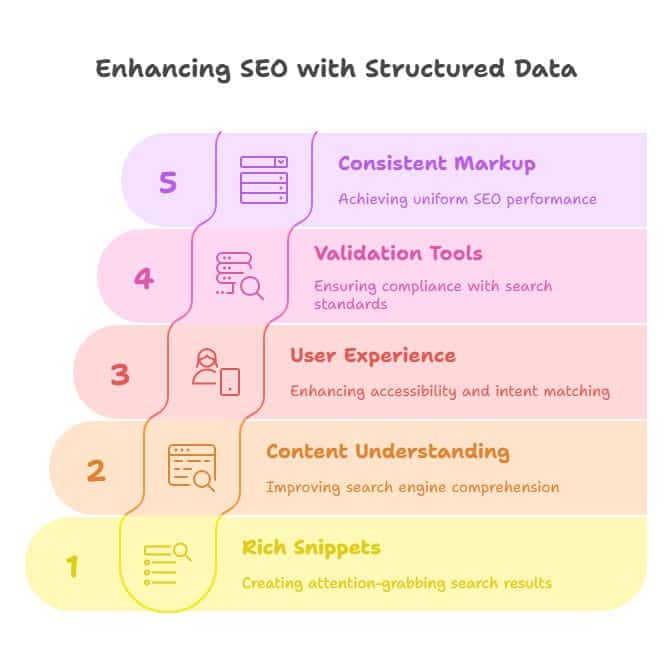
How Structured Data Enhances SEO: A Practical Guide
Structured data is an essential component of modern SEO, providing a standardized format that helps search engines accurately interpret webpage content. It enhances search visibility and user engagement by generating rich snippets, thus improving click-through rates and user experience. The integration of structured data, through formats like JSON LD and adherence to Schema.org guidelines, optimizes keyword performance and enhances content indexing. Tools for structured data creation and validation ensure accuracy and adherence to best practices. By aligning search results with user intent and improving content accessibility, structured data is a strategic asset. Discover the importance of structured data in SEO today!
Key Takeaways
- By producing rich snippets that grab users’ attention and boost click-through rates, structured data increases the visibility of search results.
- It improves how well search engines understand the content of webpages, which helps with accurate indexing and keyword optimization.
- By enhancing content accessibility and matching search results with user intent, the usage of structured data improves the user experience.
- Structured data is validated by tools like Google’s Rich Results Test, which guarantees that it qualifies for improved search result presentations.
- Consistent and precise markup across webpages is ensured by routine examination using crawling technologies, which improves overall SEO performance.

Understanding Structured Data
Understanding structured data is essential for leveraging its full potential in enhancing search engine optimization (SEO). Structured data is a standardized format for providing information about a page and classifying the page content. Its importance lies in its ability to help search engines understand the content on a webpage more effectively, thus improving visibility and search result accuracy. By embedding structured data into web pages, site owners can ensure their content is correctly interpreted and displayed in search results, which can lead to increased user engagement.
Structured data examples include information about reviews, ratings, events, product details, and business contact information, among others. These elements are often presented in the form of rich snippets in search results, offering users more detailed and relevant information at a glance. However, deploying structured data comes with certain challenges. One key challenge is ensuring that the structured data is correctly implemented and updated, as errors can lead to poor search performance. Additionally, there is often a misconception that structured data itself directly improves rankings, whereas it primarily enhances how content is displayed.
Looking towards the future, the role of structured data is expected to continue growing, with advancements in AI and machine learning further integrating these elements into search algorithms. Despite its potential, misconceptions still persist about its application and benefits. Thus, understanding structured data is not just about implementation but also recognizing its strategic importance in the broader context of digital marketing and SEO optimization. By addressing these challenges and misconceptions, businesses can better align their digital strategies with emerging technological trends.
Benefits for SEO

In the realm of digital marketing, structured data serves as a powerful tool for enhancing search engine optimization (SEO). It plays a pivotal role in keyword optimization by enabling search engines to comprehend and accurately index a website’s content. This precise data organization not only facilitates the retrieval of relevant information but also ensures that the content aligns with user intent, thereby bolstering content relevance. Consequently, this alignment can lead to improved rankings in search engine results pages (SERPs), where keyword optimization is crucial for success.
One of the most significant benefits of structured data is its ability to enhance search visibility through the generation of rich snippets. Rich snippets provide users with a concise preview of the content directly on the SERPs, which can include images, ratings, or other pertinent information. These enhanced listings are visually appealing and informative, making them more likely to capture user attention compared to standard search results. As a result, websites employing structured data often experience increased click-through rates (CTR), driving more traffic to their pages.
Moreover, structured data improves the overall user experience by ensuring that search engines deliver more precise and relevant results. By helping search engines understand the context and relationships within the content, structured data allows for more accurate indexing, which ultimately benefits both users and website owners. In turn, this leads to an environment where content relevance is prioritized, fostering a more effective connection between consumers and the information they seek. Overall, structured data is an indispensable asset in optimizing SEO efforts and maximizing online presence.
Types of Structured Data
Structured data encompasses various formats that enable the clear and organized presentation of information to search engines. By utilizing structured data, websites can enhance their visibility and ensure their content is easily interpretable by search engine algorithms. Among the primary formats employed are JSON LD format, Microdata, and RDFa, each offering unique benefits and applications.
The JSON LD format, or JavaScript Object Notation for Linked Data, is a widely favored method for embedding structured data in HTML documents. Its popularity stems from its simplicity and ease of implementation, allowing data to be easily added without altering existing HTML tags. This format supports the integration of Schema.org vocabulary, providing comprehensive metadata descriptions that contribute to generating rich snippets in search results.
Microdata usage represents another approach to structured data, where the data is embedded directly within HTML tags. This method is integral for those seeking to enhance the semantic meaning of their content, as it allows search engines to better understand the context of the information presented. Microdata also utilizes Schema.org vocabulary, ensuring consistency and clarity across web platforms.
RDFa, or Resource Description Framework in Attributes, offers another viable option for implementing structured data. RDFa examples are typically seen in contexts where data needs to be shared across different web platforms, as it allows the embedding of structured data within existing HTML attributes. This versatility makes RDFa effective for creating rich snippets that provide users with detailed previews of web content directly within search results.
Implementing Schema Markup

How can businesses ensure their websites stand out in the crowded digital landscape? Implementing schema markup is a strategic step that can enhance a site’s visibility in search results. By effectively using schema types, organizations can provide search engines with precise information about their content, leading to enriched search results and potentially increased traffic.
To achieve success with schema markup, follow these best practices:
- Choose the right schema types: Select the most relevant schema types for your content. This ensures that the information conveyed to search engines is precise and beneficial.
- Follow markup best practices: Adhere to guidelines provided by Schema.org, ensuring that your markup is clean, accurate, and up-to-date.
- Avoid common mistakes: Missteps such as incorrect placement, missing tags, or irrelevant schema types can undermine efforts. Regularly review your markup for errors.
- Utilize testing tools: Employ testing tools like Google’s Rich Results Test to validate your markup and troubleshoot any issues. This proactive approach can prevent potential problems before they arise.
As the digital landscape evolves, businesses must stay informed about future trends in schema markup. Emerging schema types and updates from search engines may present new opportunities for enhancing SEO. Keeping abreast of these changes can provide a competitive edge.
Implementing schema markup is not merely a technical task but a strategic initiative to improve search engine understanding and visibility. By adhering to best practices and avoiding common mistakes, businesses can effectively leverage schema markup to stand out in an increasingly competitive online environment.
Tools for Structured Data

Success with schema markup depends not only on implementation but also on the effective use of specialized tools that facilitate structured data management. These structured data tools are indispensable for ensuring that your schema markup enhances search engine optimization effectively. They range from structured data generators that help in creating schema markup, to schema markup validators that ensure the accuracy and adherence to guidelines.
Structured data generators, such as Google’s Structured Data Markup Helper, simplify the process of generating accurate markup by guiding users through structured data creation. This tool is particularly useful for those who are new to schema markup, providing a user-friendly interface for tagging content.
Once the markup is created, testing structured data becomes a critical step. Here, tools like Google’s Rich Results Test and Schema.org Validator are invaluable. They allow users to test their structured data to ensure it is correctly implemented and eligible for rich results. These tools provide insights into how search engines interpret your data, highlighting errors and offering suggestions for improvement.
Moreover, analyzing structured data is essential for ongoing optimization. Tools like Screaming Frog SEO Spider enable webmasters to crawl their websites, examining the presence and accuracy of structured data across multiple pages. This analysis is crucial for identifying site-wide issues and ensuring consistency.
Structured Data for E-commerce

In the competitive landscape of online retail, employing structured data for e-commerce can be a game changer for businesses aiming to enhance their visibility and user engagement. Utilizing structured data helps search engines understand website content more effectively, leading to improved search engine rankings and more appealing search results. Specifically, implementing product schema is essential for businesses that want to highlight their offerings in a detailed and organized manner.
Structured data allows for the inclusion of essential elements such as pricing markup, which ensures that potential buyers can see accurate and up-to-date prices directly in search results. This transparency builds trust and can significantly influence purchasing decisions. Moreover, review ratings integrated into the product schema provide social proof, allowing potential customers to see how others have rated a product, thus enhancing credibility and enticing more clicks.
Furthermore, inventory management can be optimized through structured data. By indicating stock availability, businesses can keep customers informed about whether a product is in stock or if they should expect delays. This information is crucial for managing customer expectations and improving the shopping experience.
Rich snippets, which are enhanced search results derived from structured data, present information in a visually appealing format. They can display product images, prices, and ratings, making the search result more attractive and informative, thereby increasing click-through rates.
Here are four reasons why adopting structured data in e-commerce matters:
- Enhanced Visibility: Stand out in search results with rich snippets.
- Increased Trust: Display accurate pricing and review ratings.
- Improved User Engagement: Offer essential product information upfront.
- Optimized Inventory Management: Keep customers informed about product availability.
Enhancing User Experience

A multitude of factors contribute to enhancing user experience on a website, with structured data playing a pivotal role. By organizing website content into a format easily interpreted by search engines, structured data enhances user engagement by ensuring that the most relevant information is presented promptly, matching the user’s search intent. This alignment between search results and user expectations can significantly reduce bounce rates, as users find exactly what they are looking for without unnecessary clicks.
Structured data improves content accessibility by making it easier for search engines to identify and display key information. This enhances visual clarity through rich snippets, such as star ratings or product availability, directly in search results. Such elements not only capture the user’s attention but also provide a clear and immediate understanding of the content, encouraging further interaction with the website.
Moreover, structured data significantly boosts navigation efficiency. For example, breadcrumb navigation markup guides users seamlessly through a site’s hierarchy, improving their ability to locate and revisit desired content. This structured approach ensures that users can effortlessly navigate complex websites, enhancing their overall experience.
Below is a table summarizing the roles of structured data in enhancing user experience:
| Aspect | Benefit | Example |
| User Engagement | Aligns search results with search intent | Reduces bounce rates |
| Content Accessibility | Highlights key information | Rich snippets |
| Visual Clarity | Provides immediate content understanding | Star ratings, price info |
| Navigation Efficiency | Facilitates easy site navigation | Breadcrumbs |
| Search Intent | Ensures relevant content is prioritized | Improved SERP positioning |
Final Thoughts
Structured data is an invaluable tool in modern SEO, helping search engines understand and present your content in ways that improve visibility, engagement, and user experience. Implementing structured data enhances your website’s performance by generating rich snippets, improving click-through rates, and aligning search results with user intent. For businesses, especially in e-commerce, it provides a competitive edge by showcasing essential product information and fostering trust through reviews and accurate pricing. By utilizing tools for structured data generation, testing, and validation, websites can ensure consistent and optimized results. In a digital landscape where search algorithms continually evolve, structured data remains a strategic asset for long-term SEO success.
Ready to leverage the power of structured data for your website? Contact Syville Gacutan, an experienced SEO Specialist in the Philippines. Syville can help you implement effective structured data strategies, boost your website’s search visibility, and achieve sustainable SEO growth. Connect today for expert guidance and proven SEO solutions!